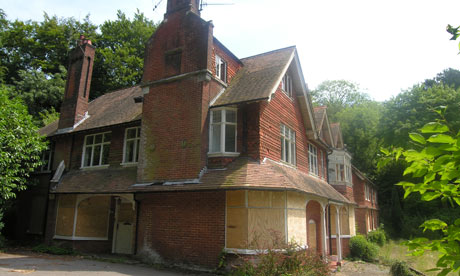Conan Doyle's home saved from redevelopment
House where Sherlock Holmes creator wrote 13 stories will remain a single building after high court ruling

Undershaw in Haslemere, Surrey, where Arthur Conan Doyle lived for 10 years. Photograph: Kathryn Ferry/Victorian Society
Sherlock Holmes fans are celebrating the foiling of an attempt to convert the Victorian house of the great detective's creator into eight separate homes.
Undershaw is a Grade II listed building at Hindhead Crossing near Haslemere in Surrey. During the decade he lived there from 1897, Sir Arthur Conan Doyle wrote 13 Holmes stories, including The Hound of the Baskervilles. The building was later turned into a hotel, and has lain empty and dilapidated since 2005.
In 2010, Waverley borough council decided to allow the owner, Fossway Ltd, to divide up the property. Campaigners trying to save the house as a single entity launched a judicial review, and have now won their case at the high court in London. Mr Justice Cranston said legal flaws meant that the council's decisions to grant planning permission and listed building consent must be quashed.
Lawyers representing John Gibson, a Conan Doyle scholar and co-founder of the Undershaw Preservation Trust, turned to one of Holmes's favourite words in lambasting the "elementary" errors of the council in its consideration of the plans.
Hailing victory in "a long and difficult battle" to save Undershaw, Gibson said: "This is a place which is steeped in history and should be treated with reverence. Conan Doyle's life and works are a fundamental part of British culture and arguably their stock has never been higher. We have been absolutely delighted to see enthusiasts from across the world get in touch and pledge their support to our efforts.
"We are very hopeful that this decision will signal a sea change in attitude towards this historic property and that it will lead to it being rightly preserved as a single building – hopefully as a museum or centre where future generations can be inspired by the many stories which have been created within its walls."
Other opponents of the scheme included the Victorian Society, local MP and culture secretary Jeremy Hunt, ex-chairman of the Arts Council Sir Christopher Frayling, Julian Barnes – who set his Booker Prize-nominated novel Arthur and George in Undershaw – writer Ian Rankin, broadcaster Stephen Fry, and Mark Gatiss, co-creator of BBC's Sherlock.
Andrew Lockley, head of public law at Irwin Mitchell, who represented Gibson, said: "The local authority failed to ensure that it received English Heritage's views on the plans before taking its decision, despite consultation with EH being a legal requirement due to the property's Grade II listed status.
"In addition, the council failed in its duty to reconsider the Fossway development plans following the submission of a second application on the property which would see it maintained as a single dwelling.
"The decision means it is now back to the drawing board in terms of the future of Undershaw, but, like John, we hope to see this property of huge cultural and historical significance preserved and treated in the manner it deserves."
The trust's website used Conan Doyle's words to galvanise its supporters for the fight: "The pressure of public opinion can do in the town what the law cannot accomplish" (a quote from The Copper Beeches) and "I shall be proud that we shall be acting together, Mr Holmes" (The Dancing Men).
Conan Doyle chose the location for Undershaw in accordance with the needs of his wife, Louise, who suffered from consumption. Before Louise's death in 1906, when he remarried and moved to Crowborough, the author entertained friends including Peter Pan author JM Barrie and Dracula creator Bram Stoker.
In a 1907 article, Stoker described Undershaw as having "all the elements of home" and said the view from the drawing room was one of "a never-ending sea of greenery" to the South Downs. Conan Doyle did not sell Undershaw until 1921 and, in 1977, it was listed as being of special architectural and historic interest because of its literary association.
Mr Justice Cranston said Fossway had clearly bought the property in 2004 for its development potential and its scheme for the house included a gazebo within the grounds, which would be open to the public and provide information about Conan Doyle.
The judge said lawyers for the council had made it clear that it wanted to preserve Undershaw and spent substantial sums to make it secure. But the the council had not adequately met statutory requirements to pay special regard to the preservation of heritage assets and planning policy.
Bryn Morgan, a councillor responsible for planning at Waverley council, said it had judged Fossway's application on its merit. "Sadly, the decision by the high court places the future of the building back in doubt once again. The poor condition of the building will now only get worse a result of this decision.
"We will now take some time to consider the judgment and will be talking to the site owners."
No comments:
Post a Comment